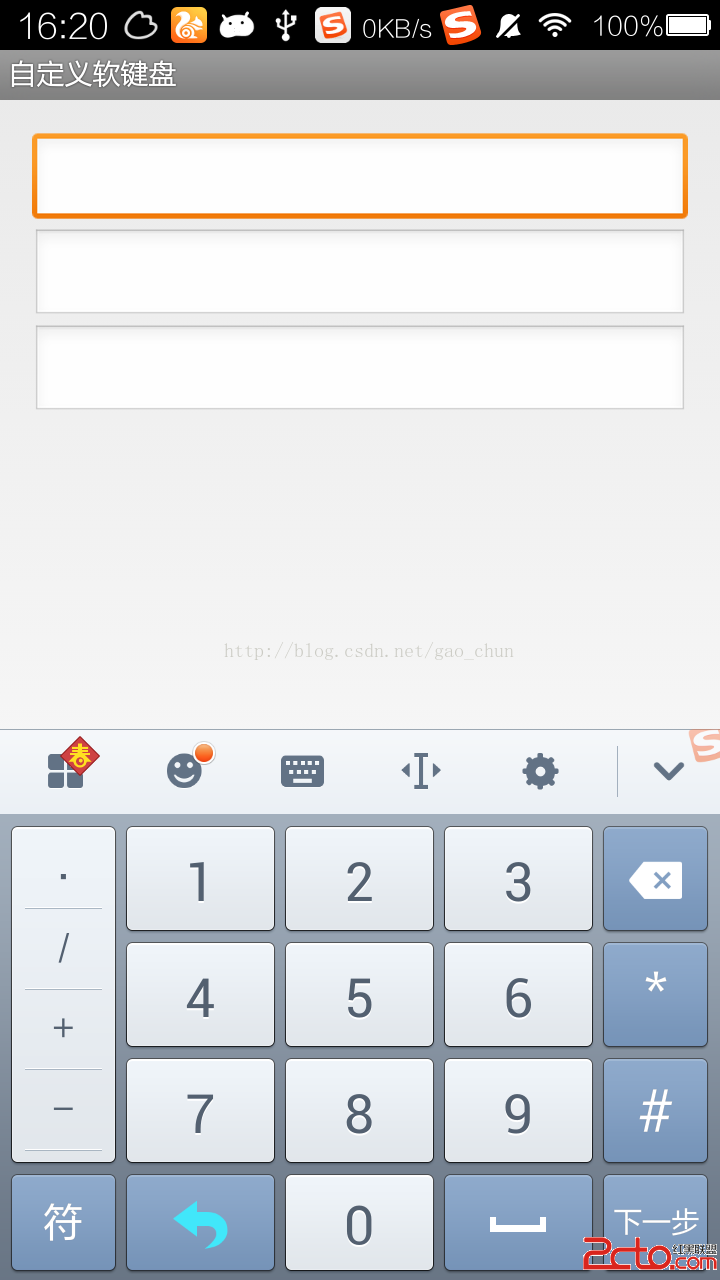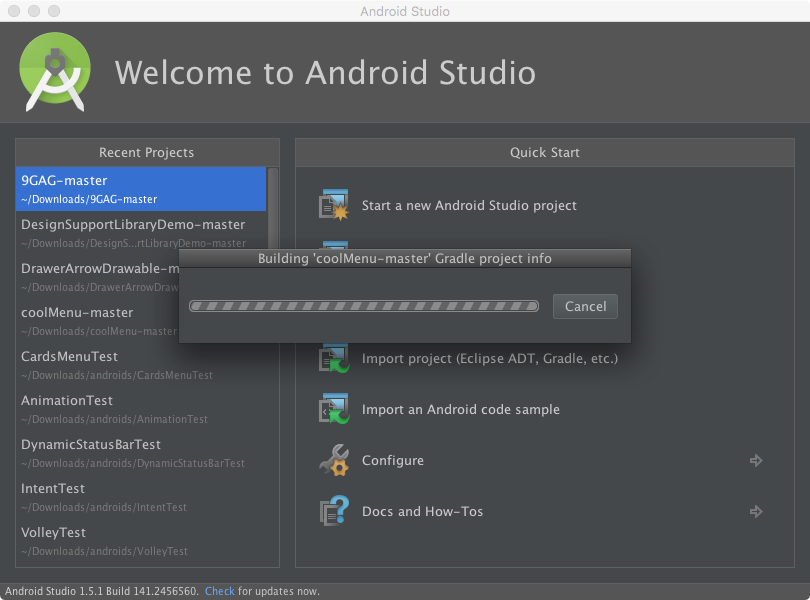編輯:關於Android編程
注意:該代碼只適用於當次簡單調用對話框,當遇到用到bundle多次調用或者傳遞信息是需要借助onPrepareDialog,但是這樣的方法已經不被推薦。
該activity代碼裡面實現了多種常用的對話框,android的對話框常見的可以有兩種實現方式:
AlertDialog方式
Dialog樣式的activity方式
該代碼實現的是AlertDialog,生命周期存在於調用的activity。
在開發中,常見的對話框包括幾個部分,標題,正文和按鈕,在實現對話框時候,可以很容易調用api實現。
new AlertDialog.Builder(AlertDialogSamples.this)
.setIconAttribute(android.R.attr.alertDialogIcon)
.setTitle(R.string.alert_dialog_two_buttons_title)
.setPositiveButton(R.string.alert_dialog_ok, new DialogInterface.OnClickListener() {
public void onClick(DialogInterface dialog, int whichButton) {
/* User clicked OK so do some stuff */
}
})
.setNegativeButton(R.string.alert_dialog_cancel, new DialogInterface.OnClickListener() {
public void onClick(DialogInterface dialog, int whichButton) {
/* User clicked Cancel so do some stuff */
}
})
.show();因此我們看到demo中使用的是在onCreateDialog(int id)中生成,而使用showDialog(int id)方法調用。
以下是程序代碼,其中set***開頭的方法是設置對話框樣式的方法,很容易理解,不贅述。
public class AlertDialogSamples extends Activity {
private static final int DIALOG_YES_NO_MESSAGE = 1;
private static final int DIALOG_YES_NO_LONG_MESSAGE = 2;
private static final int DIALOG_LIST = 3;
private static final int DIALOG_PROGRESS = 4;
private static final int DIALOG_SINGLE_CHOICE = 5;
private static final int DIALOG_MULTIPLE_CHOICE = 6;
private static final int DIALOG_TEXT_ENTRY = 7;
private static final int DIALOG_MULTIPLE_CHOICE_CURSOR = 8;
private static final int DIALOG_YES_NO_ULTRA_LONG_MESSAGE = 9;
private static final int DIALOG_YES_NO_OLD_SCHOOL_MESSAGE = 10;
private static final int DIALOG_YES_NO_HOLO_LIGHT_MESSAGE = 11;
private static final int MAX_PROGRESS = 100;
private ProgressDialog mProgressDialog;
private int mProgress;
private Handler mProgressHandler;
@Override
protected Dialog onCreateDialog(int id) {
switch (id) {
case DIALOG_YES_NO_MESSAGE:
return new AlertDialog.Builder(AlertDialogSamples.this)
.setIconAttribute(android.R.attr.alertDialogIcon)
.setTitle(R.string.alert_dialog_two_buttons_title)
.setPositiveButton(R.string.alert_dialog_ok, new DialogInterface.OnClickListener() {
public void onClick(DialogInterface dialog, int whichButton) {
/* User clicked OK so do some stuff */
}
})
.setNegativeButton(R.string.alert_dialog_cancel, new DialogInterface.OnClickListener() {
public void onClick(DialogInterface dialog, int whichButton) {
/* User clicked Cancel so do some stuff */
}
})
.create();
case DIALOG_YES_NO_OLD_SCHOOL_MESSAGE:
return new AlertDialog.Builder(AlertDialogSamples.this, AlertDialog.THEME_TRADITIONAL)
.setIconAttribute(android.R.attr.alertDialogIcon)
.setTitle(R.string.alert_dialog_two_buttons_title)
.setPositiveButton(R.string.alert_dialog_ok, new DialogInterface.OnClickListener() {
public void onClick(DialogInterface dialog, int whichButton) {
}
})
.setNegativeButton(R.string.alert_dialog_cancel, new DialogInterface.OnClickListener() {
public void onClick(DialogInterface dialog, int whichButton) {
}
})
.create();
case DIALOG_YES_NO_HOLO_LIGHT_MESSAGE:
return new AlertDialog.Builder(AlertDialogSamples.this, AlertDialog.THEME_HOLO_LIGHT)
.setIconAttribute(android.R.attr.alertDialogIcon)
.setTitle(R.string.alert_dialog_two_buttons_title)
.setPositiveButton(R.string.alert_dialog_ok, new DialogInterface.OnClickListener() {
public void onClick(DialogInterface dialog, int whichButton) {
}
})
.setNegativeButton(R.string.alert_dialog_cancel, new DialogInterface.OnClickListener() {
public void onClick(DialogInterface dialog, int whichButton) {
}
})
.create();
case DIALOG_YES_NO_LONG_MESSAGE:
return new AlertDialog.Builder(AlertDialogSamples.this)
.setIconAttribute(android.R.attr.alertDialogIcon)
.setTitle(R.string.alert_dialog_two_buttons_msg)
.setMessage(R.string.alert_dialog_two_buttons2_msg)
.setPositiveButton(R.string.alert_dialog_ok, new DialogInterface.OnClickListener() {
public void onClick(DialogInterface dialog, int whichButton) {
/* User clicked OK so do some stuff */
}
})
.setNeutralButton(R.string.alert_dialog_something, new DialogInterface.OnClickListener() {
public void onClick(DialogInterface dialog, int whichButton) {
/* User clicked Something so do some stuff */
}
})
.setNegativeButton(R.string.alert_dialog_cancel, new DialogInterface.OnClickListener() {
public void onClick(DialogInterface dialog, int whichButton) {
/* User clicked Cancel so do some stuff */
}
})
.create();
case DIALOG_YES_NO_ULTRA_LONG_MESSAGE:
return new AlertDialog.Builder(AlertDialogSamples.this)
.setIconAttribute(android.R.attr.alertDialogIcon)
.setTitle(R.string.alert_dialog_two_buttons_msg)
.setMessage(R.string.alert_dialog_two_buttons2ultra_msg)
.setPositiveButton(R.string.alert_dialog_ok, new DialogInterface.OnClickListener() {
public void onClick(DialogInterface dialog, int whichButton) {
/* User clicked OK so do some stuff */
}
})
.setNeutralButton(R.string.alert_dialog_something, new DialogInterface.OnClickListener() {
public void onClick(DialogInterface dialog, int whichButton) {
/* User clicked Something so do some stuff */
}
})
.setNegativeButton(R.string.alert_dialog_cancel, new DialogInterface.OnClickListener() {
public void onClick(DialogInterface dialog, int whichButton) {
/* User clicked Cancel so do some stuff */
}
})
.create();
case DIALOG_LIST:
return new AlertDialog.Builder(AlertDialogSamples.this)
.setTitle(R.string.select_dialog)
.setItems(R.array.select_dialog_items, new DialogInterface.OnClickListener() {
public void onClick(DialogInterface dialog, int which) {
/* User clicked so do some stuff */
String[] items = getResources().getStringArray(R.array.select_dialog_items);
new AlertDialog.Builder(AlertDialogSamples.this)
.setMessage("You selected: " + which + " , " + items[which])
.show();
}
})
.create();
case DIALOG_PROGRESS:
mProgressDialog = new ProgressDialog(AlertDialogSamples.this);
mProgressDialog.setIconAttribute(android.R.attr.alertDialogIcon);
mProgressDialog.setTitle(R.string.select_dialog);
mProgressDialog.setProgressStyle(ProgressDialog.STYLE_HORIZONTAL);
mProgressDialog.setMax(MAX_PROGRESS);
mProgressDialog.setButton(DialogInterface.BUTTON_POSITIVE,
getText(R.string.alert_dialog_hide), new DialogInterface.OnClickListener() {
public void onClick(DialogInterface dialog, int whichButton) {
/* User clicked Yes so do some stuff */
}
});
mProgressDialog.setButton(DialogInterface.BUTTON_NEGATIVE,
getText(R.string.alert_dialog_cancel), new DialogInterface.OnClickListener() {
public void onClick(DialogInterface dialog, int whichButton) {
/* User clicked No so do some stuff */
}
});
return mProgressDialog;
case DIALOG_SINGLE_CHOICE:
return new AlertDialog.Builder(AlertDialogSamples.this)
.setIconAttribute(android.R.attr.alertDialogIcon)
.setTitle(R.string.alert_dialog_single_choice)
.setSingleChoiceItems(R.array.select_dialog_items2, 0, new DialogInterface.OnClickListener() {
public void onClick(DialogInterface dialog, int whichButton) {
/* User clicked on a radio button do some stuff */
}
})
.setPositiveButton(R.string.alert_dialog_ok, new DialogInterface.OnClickListener() {
public void onClick(DialogInterface dialog, int whichButton) {
/* User clicked Yes so do some stuff */
}
})
.setNegativeButton(R.string.alert_dialog_cancel, new DialogInterface.OnClickListener() {
public void onClick(DialogInterface dialog, int whichButton) {
/* User clicked No so do some stuff */
}
})
.create();
case DIALOG_MULTIPLE_CHOICE:
return new AlertDialog.Builder(AlertDialogSamples.this)
.setIcon(R.drawable.ic_popup_reminder)
.setTitle(R.string.alert_dialog_multi_choice)
.setMultiChoiceItems(R.array.select_dialog_items3,
new boolean[]{false, true, false, true, false, false, false},
new DialogInterface.OnMultiChoiceClickListener() {
public void onClick(DialogInterface dialog, int whichButton,
boolean isChecked) {
/* User clicked on a check box do some stuff */
}
})
.setPositiveButton(R.string.alert_dialog_ok,
new DialogInterface.OnClickListener() {
public void onClick(DialogInterface dialog, int whichButton) {
/* User clicked Yes so do some stuff */
}
})
.setNegativeButton(R.string.alert_dialog_cancel,
new DialogInterface.OnClickListener() {
public void onClick(DialogInterface dialog, int whichButton) {
/* User clicked No so do some stuff */
}
})
.create();
case DIALOG_MULTIPLE_CHOICE_CURSOR:
String[] projection = new String[] {
ContactsContract.Contacts._ID,
ContactsContract.Contacts.DISPLAY_NAME,
ContactsContract.Contacts.SEND_TO_VOICEMAIL
};
Cursor cursor = managedQuery(ContactsContract.Contacts.CONTENT_URI,
projection, null, null, null);
return new AlertDialog.Builder(AlertDialogSamples.this)
.setIcon(R.drawable.ic_popup_reminder)
.setTitle(R.string.alert_dialog_multi_choice_cursor)
.setMultiChoiceItems(cursor,
ContactsContract.Contacts.SEND_TO_VOICEMAIL,
ContactsContract.Contacts.DISPLAY_NAME,
new DialogInterface.OnMultiChoiceClickListener() {
public void onClick(DialogInterface dialog, int whichButton,
boolean isChecked) {
Toast.makeText(AlertDialogSamples.this,
"Readonly Demo Only - Data will not be updated",
Toast.LENGTH_SHORT).show();
}
})
.create();
case DIALOG_TEXT_ENTRY:
// This example shows how to add a custom layout to an AlertDialog
LayoutInflater factory = LayoutInflater.from(this);
final View textEntryView = factory.inflate(R.layout.alert_dialog_text_entry, null);
return new AlertDialog.Builder(AlertDialogSamples.this)
.setIconAttribute(android.R.attr.alertDialogIcon)
.setTitle(R.string.alert_dialog_text_entry)
.setView(textEntryView)
.setPositiveButton(R.string.alert_dialog_ok, new DialogInterface.OnClickListener() {
public void onClick(DialogInterface dialog, int whichButton) {
/* User clicked OK so do some stuff */
}
})
.setNegativeButton(R.string.alert_dialog_cancel, new DialogInterface.OnClickListener() {
public void onClick(DialogInterface dialog, int whichButton) {
/* User clicked cancel so do some stuff */
}
})
.create();
}
return null;
}
/**
* Initialization of the Activity after it is first created. Must at least
* call {@link android.app.Activity#setContentView(int)} to
* describe what is to be displayed in the screen.
*/
@Override
protected void onCreate(Bundle savedInstanceState) {
super.onCreate(savedInstanceState);
setContentView(R.layout.alert_dialog);
/* Display a text message with yes/no buttons and handle each message as well as the cancel action */
Button twoButtonsTitle = (Button) findViewById(R.id.two_buttons);
twoButtonsTitle.setOnClickListener(new OnClickListener() {
public void onClick(View v) {
showDialog(DIALOG_YES_NO_MESSAGE);
}
});
/* Display a long text message with yes/no buttons and handle each message as well as the cancel action */
Button twoButtons2Title = (Button) findViewById(R.id.two_buttons2);
twoButtons2Title.setOnClickListener(new OnClickListener() {
public void onClick(View v) {
showDialog(DIALOG_YES_NO_LONG_MESSAGE);
}
});
/* Display an ultra long text message with yes/no buttons and handle each message as well as the cancel action */
Button twoButtons2UltraTitle = (Button) findViewById(R.id.two_buttons2ultra);
twoButtons2UltraTitle.setOnClickListener(new OnClickListener() {
public void onClick(View v) {
showDialog(DIALOG_YES_NO_ULTRA_LONG_MESSAGE);
}
});
/* Display a list of items */
Button selectButton = (Button) findViewById(R.id.select_button);
selectButton.setOnClickListener(new OnClickListener() {
public void onClick(View v) {
showDialog(DIALOG_LIST);
}
});
/* Display a custom progress bar */
Button progressButton = (Button) findViewById(R.id.progress_button);
progressButton.setOnClickListener(new OnClickListener() {
public void onClick(View v) {
showDialog(DIALOG_PROGRESS);
mProgress = 0;
mProgressDialog.setProgress(0);
mProgressHandler.sendEmptyMessage(0);
}
});
/* Display a radio button group */
Button radioButton = (Button) findViewById(R.id.radio_button);
radioButton.setOnClickListener(new OnClickListener() {
public void onClick(View v) {
showDialog(DIALOG_SINGLE_CHOICE);
}
});
/* Display a list of checkboxes */
Button checkBox = (Button) findViewById(R.id.checkbox_button);
checkBox.setOnClickListener(new OnClickListener() {
public void onClick(View v) {
showDialog(DIALOG_MULTIPLE_CHOICE);
}
});
/* Display a list of checkboxes, backed by a cursor */
Button checkBox2 = (Button) findViewById(R.id.checkbox_button2);
checkBox2.setOnClickListener(new OnClickListener() {
public void onClick(View v) {
showDialog(DIALOG_MULTIPLE_CHOICE_CURSOR);
}
});
/* Display a text entry dialog */
Button textEntry = (Button) findViewById(R.id.text_entry_button);
textEntry.setOnClickListener(new OnClickListener() {
public void onClick(View v) {
showDialog(DIALOG_TEXT_ENTRY);
}
});
/* Two points, in the traditional theme */
Button twoButtonsOldSchoolTitle = (Button) findViewById(R.id.two_buttons_old_school);
twoButtonsOldSchoolTitle.setOnClickListener(new OnClickListener() {
public void onClick(View v) {
showDialog(DIALOG_YES_NO_OLD_SCHOOL_MESSAGE);
}
});
/* Two points, in the light holographic theme */
Button twoButtonsHoloLightTitle = (Button) findViewById(R.id.two_buttons_holo_light);
twoButtonsHoloLightTitle.setOnClickListener(new OnClickListener() {
public void onClick(View v) {
showDialog(DIALOG_YES_NO_HOLO_LIGHT_MESSAGE);
}
});
mProgressHandler = new Handler() {
@Override
public void handleMessage(Message msg) {
super.handleMessage(msg);
if (mProgress >= MAX_PROGRESS) {
mProgressDialog.dismiss();
} else {
mProgress++;
mProgressDialog.incrementProgressBy(1);
mProgressHandler.sendEmptyMessageDelayed(0, 100);
}
}
};
}
}開發者可以使用該代碼依次看一看每個對話框是什麼樣子的
該代碼實現的只是簡單的對話框,對於多次調用或者更新信息等動態信息的對話框是有問題的,因為,他的回調方法只能調用一次,以後多次調用時的數據都是第一次的,不適用於Bundle傳遞數據的使用場景。
 Android Camera HAL3中預覽preview模式下的控制流
Android Camera HAL3中預覽preview模式下的控制流
本文均屬自己閱讀源碼的點滴總結,轉賬請注明出處謝謝。歡迎和大家交流。qq:1037701636 email:[email protected]:系統
 Android 中自定義軟鍵盤
Android 中自定義軟鍵盤
Android 中自定義軟鍵盤 圖一為搜狗輸入法、圖二為自定義密碼鍵盤、圖三為自定義密碼鍵盤 java源文件 package
 解決Android Studio導入項目非常慢的辦法
解決Android Studio導入項目非常慢的辦法
前言大家都知道Android Studio目前已經更新到2.0 Preview 6了,作為Google大力推崇的開發工具,相對於Eclipse ADT有著不可比擬的優勢。
 Android開發之電話撥號器和短信發送器實現方法
Android開發之電話撥號器和短信發送器實現方法
本文實例講述了Android開發之電話撥號器和短信發送器實現方法。分享給大家供大家參考,具體如下:電話撥號器實現原理:用戶輸入電話號碼,當點擊撥打的時候,由監聽對象捕獲,